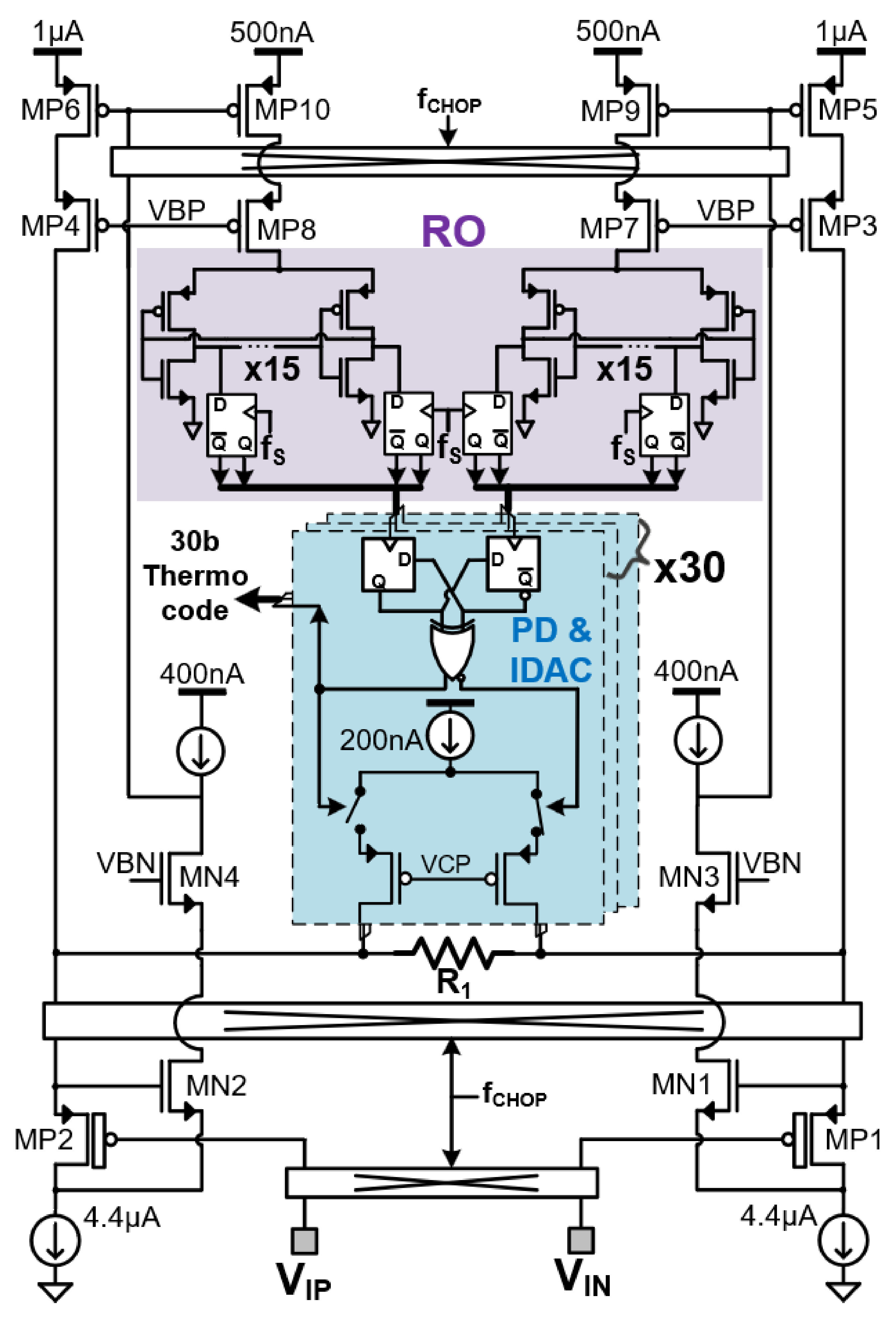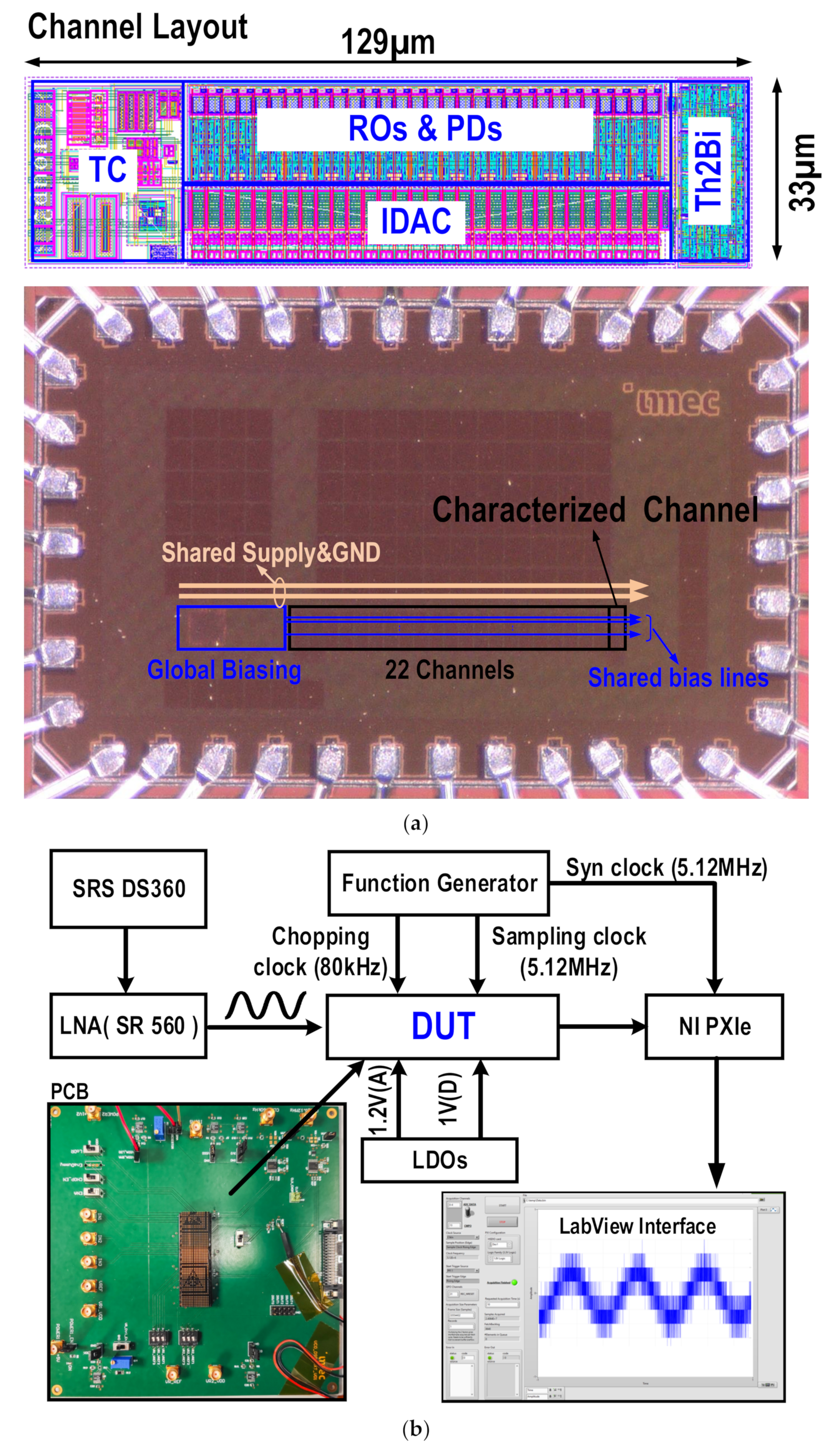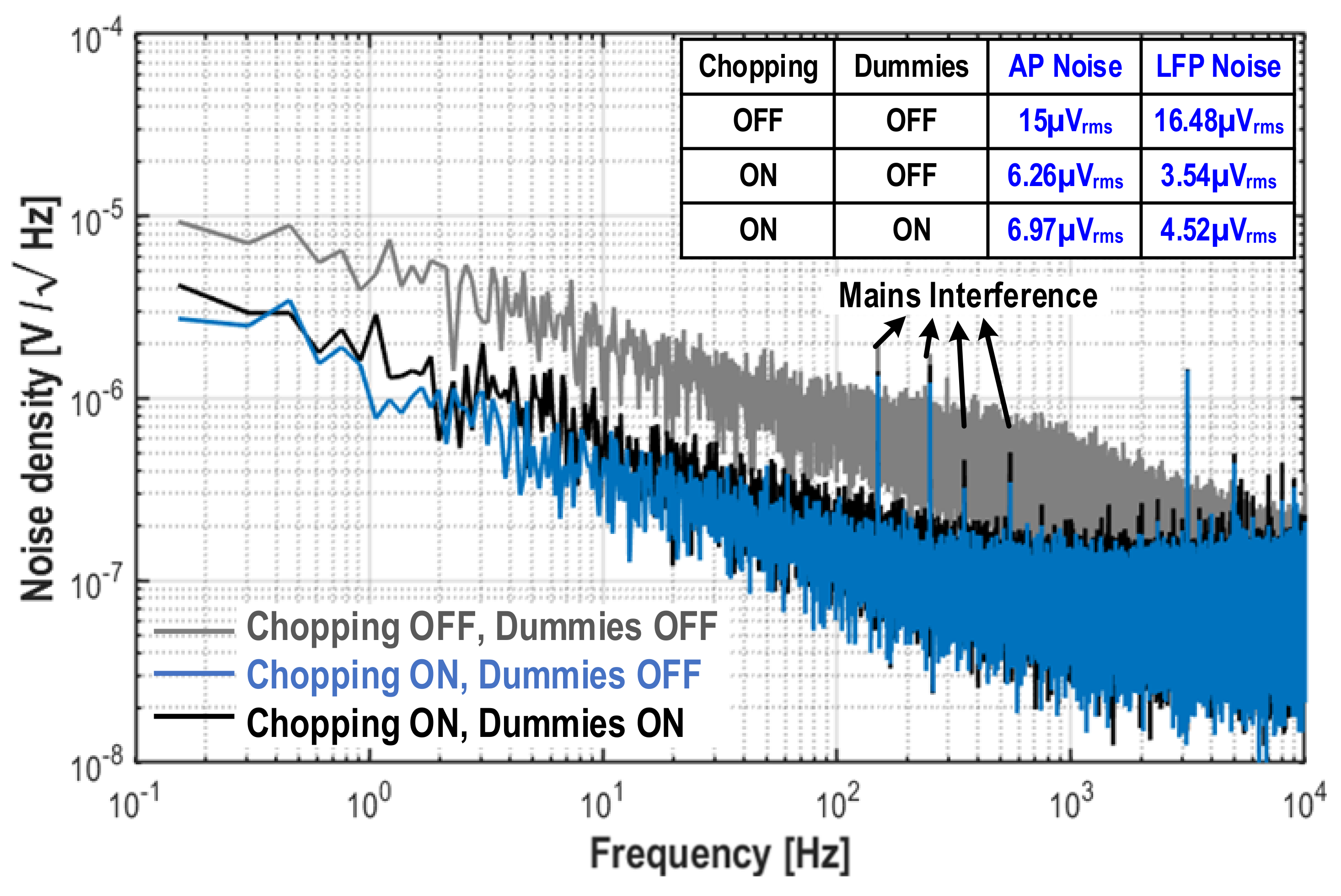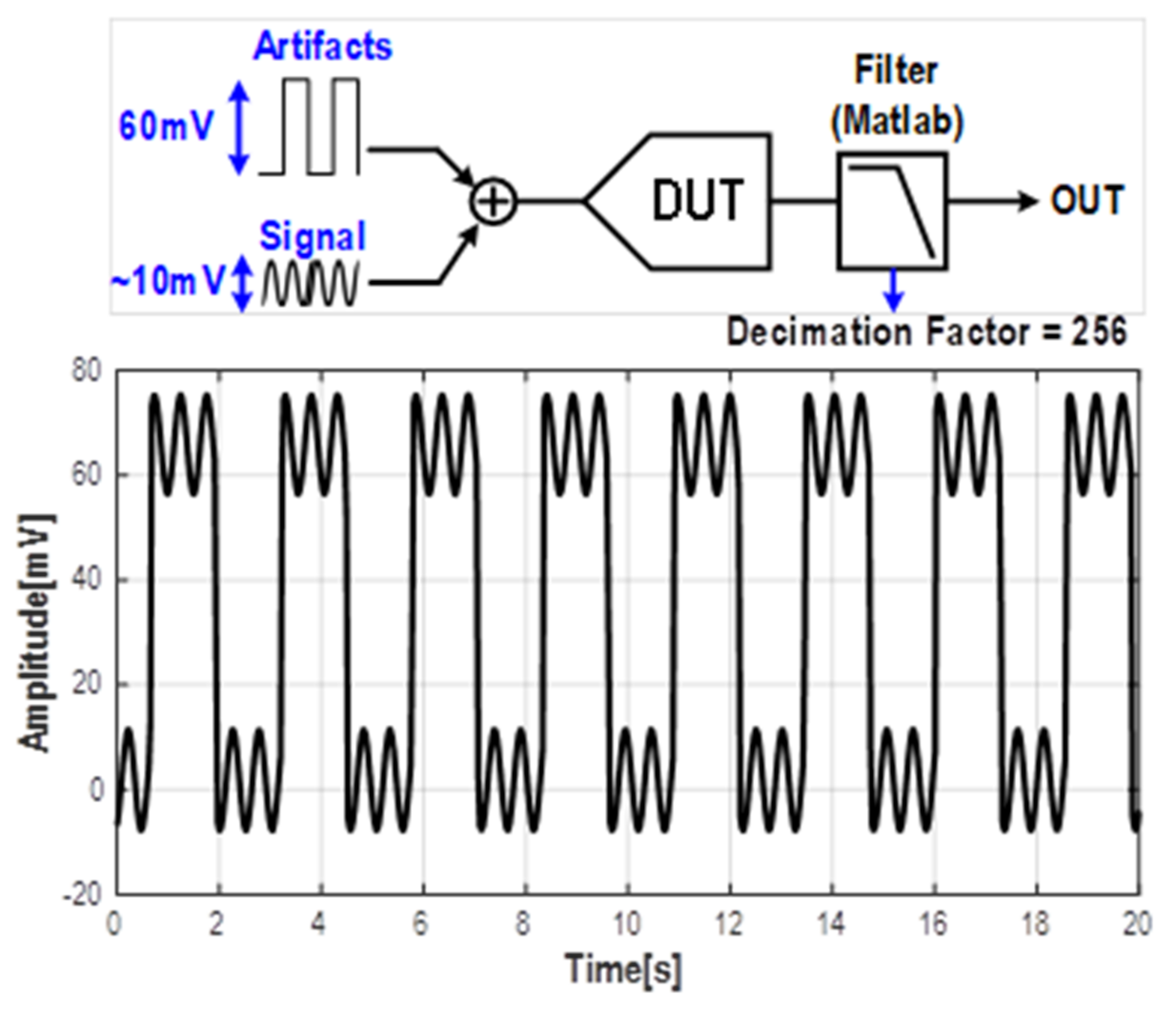A 0.00426 mm2 77.6-dB Dynamic Range VCO-Based CTDSM for Multi-Channel Neural Recording
Abstract
:1. Introduction
2. Modulator Architecture
3. Schematic Design
4. Results and Discussion
5. Conclusions
Author Contributions
Funding
Institutional Review Board Statement
Informed Consent Statement
Acknowledgments
Conflicts of Interest
References
- Jun, J.J.; Steinmetz, N.A.; Siegle, J.H.; Denman, D.J.; Bauza, M.; Barbarits, B.; Lee, A.K.; Anastassiou, C.A.; Andrei, A.; Aydin, C.; et al. Fully integrated silicon probes for high-density recording of neural activity. Nature 2017, 551, 232–236. [Google Scholar] [CrossRef] [PubMed] [Green Version]
- Steinmetz, N.A.; Aydin, C.; Lebedeva, A.; Okun, M.; Pachitariu, M.; Bauza, M.; Beau, M.; Bhagat, J.; Böhm, C.; Broux, M.; et al. Neuropixels 2.0: A miniaturized high-density probe for stable, long-term brain recordings. Science 2021, 372, 6539. [Google Scholar] [CrossRef] [PubMed]
- Stringer, C.; Pachitariu, M.; Steinmetz, N.; Reddy, C.B.; Carandini, M.; Harris, K.D. Spontaneous behaviors drive multidimensional brainwide activity. Science 2019, 364, 6437. [Google Scholar] [CrossRef] [PubMed]
- Steinmetz, N.A.; Zatka-Haas, P.; Carandini, M.; Harris, K.D. Distributed coding of choice, action and engagement across the mouse brain. Nature 2019, 576, 266–273. [Google Scholar] [CrossRef] [PubMed]
- Gardner, R.J.; Hermansen, E.; Pachitariu, M.; Burak, Y.; Baas, N.A.; Dunn, B.A.; Moser, M.-B.; Moser, E.I. Toroidal topology of population activity in grid cells. Nature 2022, 602, 123–128. [Google Scholar] [CrossRef]
- Urai, A.E.; Doiron, B.; Leifer, A.M.; Churchland, A.K. Large-scale neural recordings call for new insights to link brain and behavior. Nat. Neurosci. 2022, 25, 11–19. [Google Scholar] [CrossRef]
- Park, S.; Cho, J.; Na, K.; Yoon, E. Modular 128-Channel Δ − ΔΣ analog front-end architecture using spectrum equalization scheme for 1024-Channel 3-D neural recording microsystems. IEEE J. Solid State Circuits 2018, 53, 501–514. [Google Scholar] [CrossRef]
- Lopez, C.M.; Putzeys, J.; Raducanu, B.C.; Ballini, M.; Wang, S.; Andrei, A.; Rochus, V.; Vandebriel, R.; Severi, S.; Van Hoof, C.; et al. A Neural Probe With Up to 966 Electrodes and Up to 384 Configurable Channels in 0.13 µm SOI CMOS. IEEE Trans. Biomed. Circuits Syst. 2017, 11, 510–522. [Google Scholar] [CrossRef] [Green Version]
- Wang, S.; Garakoui, S.K.; Chun, H.; Salinas, D.G.; Sijbers, W.; Putzeys, J.; Martens, E.; Craninckx, J.; Van Helleputte, N.; Lopez, C.M. A Compact Quad-Shank CMOS Neural Probe With 5,120 Addressable Recording Sites and 384 Fully Differential Parallel Channels. IEEE Trans. Biomed. Circuits Syst. 2020, 60, 2889–2901. [Google Scholar] [CrossRef]
- Yoon, D.-Y.; Pinto, S.; Chung, S.; Merolla, P.; Koh, T.-W.; Seo, D. A 1024-channel simultaneous recording neural SoC with stimulation and real-time spike detection. In Proceedings of the 2021 Symposium on VLSI Circuits, Kyoto, Japan, 13–19 June 2021. [Google Scholar] [CrossRef]
- Yang, X.; Ballini, M.; Sawigun, C.; Hsu, W.-Y.; Weijers, J.-W.; Putzeys, J.; Lopez, C.M. A 128-Channel AC-Coupled 1st-order Δ-Δ∑ IC for Neural Signal Acquisition. In Proceedings of the 2022 IEEE Symposium on VLSI Technology and Circuits (VLSI Technology and Circuits), Honolulu, HI, USA, 12–17 June 2022; pp. 60–61. [Google Scholar] [CrossRef]
- Liu, Y.; Luan, S.; Williams, I.; Rapeaux, A.; Constandinou, T.G. A 64-Channel Versatile Neural Recording SoC With Activity-Dependent Data Throughput. IEEE Trans. Biomed. Circuits Syst. 2017, 11, 1344–1355. [Google Scholar] [CrossRef] [Green Version]
- Ballini, M.; Muller, J.; Livi, P.; Chen, Y.; Frey, U.; Stettler, A.; Shadmani, A.; Viswam, V.; Lloyd Jones, I.; Jackel, D.; et al. A 1024-Channel CMOS Microelectrode Array with 26,400 Electrodes for Recording and Stimulation of Electrogenic Cells In Vitro. IEEE J. Solid State Circuits 2014, 49, 2705–2719. [Google Scholar] [CrossRef] [Green Version]
- Dragas, J.; Viswam, V.; Shadmani, A.; Chen, Y.; Bounik, R.; Stettler, A.; Radivojevic, M.; Geissler, S.; Obien, M.E.J.; Muller, J.; et al. In Vitro Multi-Functional Microelectrode Array Featuring 59 760 Electrodes, 2048 Electrophysiology Channels, Stimulation, Impedance Measurement, and Neurotransmitter Detection Channels. IEEE J. Solid State Circuits 2017, 52, 1576–1590. [Google Scholar] [CrossRef] [Green Version]
- De Dorigo, D.; Moranz, C.; Graf, H.; Marx, M.; Wendler, D.; Shui, B.; Herbawi, A.S.; Kuhl, M.; Ruther, P.; Paul, O.; et al. Fully Immersible Subcortical Neural Probes with Modular Architecture and a Delta-Sigma ADC Integrated Under Each Electrode for Parallel Readout of 144 Recording Sites. IEEE J. Solid State Circuits 2018, 53, 3111–3125. [Google Scholar] [CrossRef]
- Lee, C.; Jeon, T.; Jang, M.; Park, S.; Kim, J.; Lim, J.; Ahn, J.-H.; Huh, Y.; Chae, Y. A 6.5-μW 10-kHz BW 80.4-dB SNDR Gₘ-C-Based CT ΔΣ Modulator with a Feedback-Assisted Gₘ Linearization for Artifact-Tolerant Neural Recording. IEEE J. Solid State Circuits 2020, 60, 2889–2901. [Google Scholar] [CrossRef]
- Wendler, D.; De Dorigo, D.; Amayreh, M.; Bleitner, A.; Marx, M.; Manoli, Y. A 0.0046-mm2 Two-Step Incremental Delta—Sigma Analog-to-Digital Converter Neuronal Recording Front End With 120-mVpp Offset Compensation. IEEE J. Solid State Circuits 2022, in press. [Google Scholar] [CrossRef]
- Wang, S.; Ballini, M.; Yang, X.; Sawigun, C.; Weijers, J.-W.; Biswas, D.; Van Helleputte, N.; Lopez, C.M. A Compact Chopper Stabilized Δ-ΔΣ Neural Readout IC with Input Impedance Boosting. IEEE Open J. Solid State Circuits Soc. 2021, 1, 67–78. [Google Scholar] [CrossRef]
- Huang, X.; Ballini, M.; Wang, S.; Miccoli, B.; Van Hoof, C.; Gielen, G.; Craninckx, J.; Van Helleputte, N.; Lopez, C.M. A Compact, Low-Power Analog Front-end With Event-Driven Input Biasing for High-Density Neural Recording in 22-nm FDSOI. IEEE Trans. Circuits Syst. II Exp. Briefs. 2022, 69, 804–808. [Google Scholar] [CrossRef]
- Pavan, S.; Schreier, R.; Temes, G.C. Understanding Delta-Sigma Data Converter; Wiley: Hoboken, NJ, USA, 2017. [Google Scholar]
- Jiang, W.; Hokhikyan, V.; Chandrakumar, H.; Karkare, V.; Markovic, D. A ±50mV linear-input-range VCO-based neural-recording front-end with digital nonlinearity correction. In Proceedings of the 2016 IEEE International Solid-State Circuits Conference (ISSCC), San Francisco, CA, USA, 31 January–4 February 2016; pp. 484–485. [Google Scholar] [CrossRef]
- Jeon, H.; Bang, J.-S.; Jung, Y.; Choi, I.; Je, M. A High DR, DC-Coupled, Time-Based Neural-Recording IC with Degeneration R-DAC for Bidirectional Neural Interface. IEEE J. Solid State Circuits 2019, 54, 2658–2670. [Google Scholar] [CrossRef]
- Liu, H.; Guo, T.; Yan, P.; Qi, L.; Chen, M.; Wang, G.; Liu, Y. A Hybrid 1st/2nd-Order VCO-Based CTDSM with Rail-to-Rail Artifact Tolerance for Bidirectional Neural Interface. IEEE Trans. Circuits Syst. II. Exp. Briefs. 2022, 69, 2682–2686. [Google Scholar] [CrossRef]
- Zhao, W.; Li, S.; Xu, B.; Yang, X.; Tang, X.; Shen, L.; Lu, N.; Pan, D.Z.; Sun, N. A 0.025-mm2 0.8-V 78.5-dB SNDR VCO-Based Sensor Readout Circuit in a Hybrid PLL-ΔΣ M Structure. IEEE J. Solid State Circuits 2020, 55, 666–679. [Google Scholar] [CrossRef]
- Huang, J.; Mercier, P.P. A 178.9-dB FoM 128-dB SFDR VCO-Based AFE for ExG Readouts with a Calibration-Free Differential Pulse Code Modulation Technique. IEEE Trans. Circuits Syst. II Exp. Briefs. 2022, 69, 804–808. [Google Scholar] [CrossRef]
- Pochet, C.; Hall, D.A. A 4.4µW 2.5 kHz-BW 92.1dB-SNDR 3rd-Order VCO-Based ADC with Pseudo Virtual Ground Feedforward Linearization. IEEE J. Solid State Circuits 2021, 56, 3236–3246. [Google Scholar]








| Parameters | Value |
|---|---|
| TC transconductance (gm) | 30.5 µS |
| IDAC LSB current (ILSB) | 200 nA |
| RO gain () | 610 GHz/A |
| Quantization levels () | 30 |
| Quantizer gain () | 30/2 π = 4.77 |
| Feed-in coefficient () | 22.9 |
| Feedback coefficient () | 0.15 |
| Sampling rate () | 5.12 MHz (256 × OSR) |
| Parameters | This Work | [18] | [17] | [16] | [24] †† | [25] †† | [26] †† |
|---|---|---|---|---|---|---|---|
| Technology | 55 nm | 55 nm | 180 nm | 110 nm | 40 nm | 65 nm | 65 nm |
| Supply voltage (V) | 1.2 (Analog)/1.0 (Digital) | 1.2 | 1.8 | 1.0 | 0.8 (Analog)/0.6 (Digital) | 0.8 | 0.8 |
| Channel topology | 1st-order VCO-based CTDSM | 2nd-order ∆-∆Σ CTDSM | Two-step CT Incremental ∆Σ | 2nd-order CTDSM (VCO as 2nd integrator) | 2nd-order VCO-PLL hybrid | 1st-order VCO-based | 3rd-order VCO-based CTDSM |
| Input Impedance (Ω) | 640 M@10 Hz | 663 M@10 Hz | ∞@DC * | ∞@DC *; 13.3 M@10 kHz | 222 k ~ 14.2 M * | 8 M | Unknown * |
| Max. input range (mVpp) | 149 | 148 | 15.2 | 300 | 100/400 | 460 | 1800 |
| THD @1 kHz input | 0.09~0.18%@ 10 mVpp AC ± 68 mV DC | 0.05~0.44%@ 20 mVpp AC ± 70 mV DC | 0.078% @10 mVpp | 0.0095% @285 mVpp | 0.01% @90 mVpp | <0.002% @460 mVpp (90 Hz) | <0.0025% @1.8 Vpp (322 Hz) |
| Bandwidth (kHz) | 10 | 10 | 10 | 10 | 10 | 0.5 | 2.5 |
| AP band noise (µVrms) | 6.26 † ~ 6.97 | 5.53 | 4.46 | 9.5 (1 Hz ~10 kHz) † | 3.6 (10 Hz ~ 10 kHz) † | 2.6 (10 ~500 Hz) † | 15.8 (1 Hz ~2.5 kHz) † |
| LFP band noise (µVrms) | 3.54 † ~ 4.52 | 2.88 | 2.51 | ||||
| Power/channel (µW) | 13.75 ** | 48.7 | 14.62 | 6.5 ** | 4.68 ** | 1.68 ** | 4.4 ** |
| Area/channel (mm2) | 0.00426 ** | 0.0077 | 0.00462 | 0.078 ** | 0.025 ** | 0.056 ** | 0.1 ** |
Publisher’s Note: MDPI stays neutral with regard to jurisdictional claims in published maps and institutional affiliations. |
© 2022 by the authors. Licensee MDPI, Basel, Switzerland. This article is an open access article distributed under the terms and conditions of the Creative Commons Attribution (CC BY) license (https://creativecommons.org/licenses/by/4.0/).
Share and Cite
Wang, S.; Yang, X.; Wang, C.; Vilouras, A.; Lopez, C.M. A 0.00426 mm2 77.6-dB Dynamic Range VCO-Based CTDSM for Multi-Channel Neural Recording. Electronics 2022, 11, 3477. https://doi.org/10.3390/electronics11213477
Wang S, Yang X, Wang C, Vilouras A, Lopez CM. A 0.00426 mm2 77.6-dB Dynamic Range VCO-Based CTDSM for Multi-Channel Neural Recording. Electronics. 2022; 11(21):3477. https://doi.org/10.3390/electronics11213477
Chicago/Turabian StyleWang, Shiwei, Xiaolin Yang, Chaohan Wang, Anastasios Vilouras, and Carolina Mora Lopez. 2022. "A 0.00426 mm2 77.6-dB Dynamic Range VCO-Based CTDSM for Multi-Channel Neural Recording" Electronics 11, no. 21: 3477. https://doi.org/10.3390/electronics11213477
APA StyleWang, S., Yang, X., Wang, C., Vilouras, A., & Lopez, C. M. (2022). A 0.00426 mm2 77.6-dB Dynamic Range VCO-Based CTDSM for Multi-Channel Neural Recording. Electronics, 11(21), 3477. https://doi.org/10.3390/electronics11213477







